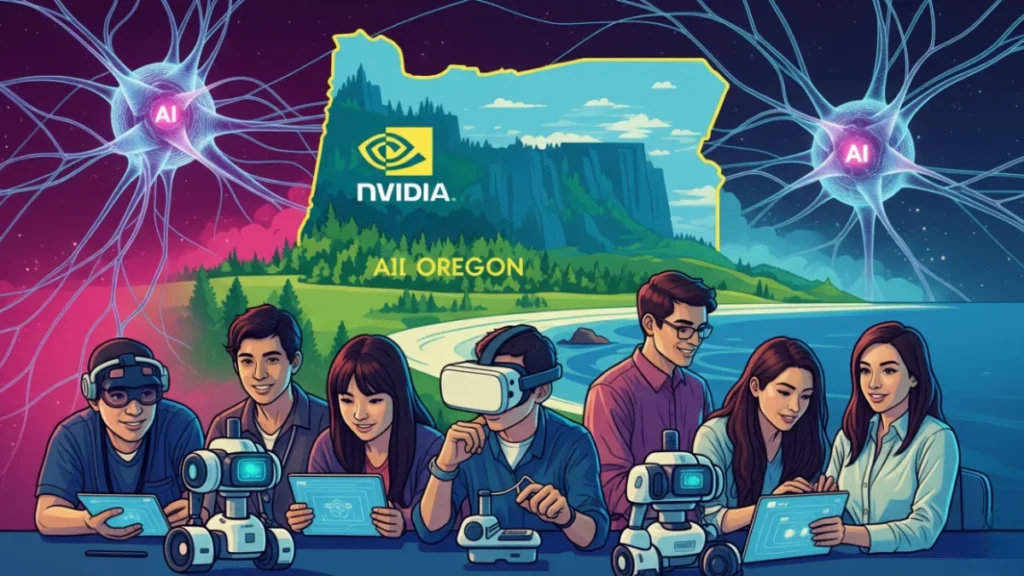Oregon’s $10M agreement with Nvidia aims to introduce AI lessons from kindergarten to college—but how and what students will actually learn remains murky. While the deal promises future-ready education, educators and experts are urging caution about who controls the message.
Key Takeaways:
- Oregon signed a $10 million deal with Nvidia to integrate AI education into K-12 and college curricula.
- The agreement promises AI “literacy” but lacks clear guidance on lesson content, ethics, or application.
- Critics question Nvidia’s role, raising concerns about bias and corporate influence in public schools.
- Faculty can become certified “Nvidia Ambassadors” to promote AI education on campuses.
- Other states like California, Mississippi, and Utah have signed similar AI deals.
Oregon just stepped onto the national stage in the AI education race—backed by a $10 million agreement with tech giant Nvidia. The deal, signed by Governor Tina Kotek in April 2025, aims to infuse artificial intelligence education into classrooms, from kindergarten all the way through college.
But while the vision sounds cutting-edge, a closer look reveals more questions than answers.
Despite the high-profile signatures and promising headlines, the agreement leaves out major details—like how AI will be taught to 5-year-olds, or what ethical frameworks will guide instruction. The Oregon Department of Education hasn’t released specifics, and the state’s largest teacher’s union has stayed silent on the matter.
So what exactly does this deal mean for students, parents, and educators?
A Big Bet on AI—and Nvidia
Nvidia, the world’s leading chipmaker behind systems like ChatGPT, is offering Oregon access to training, certifications, and AI career pathways. College faculty can become “Nvidia Ambassadors” and teach advanced machine learning courses. For K-12 schools, the focus will be on “foundational AI concepts.”
Governor Kotek’s office said the initiative is meant to prepare Oregon’s workforce for a tech-driven future. That includes industries like healthcare, agriculture, and microelectronics—especially semiconductor manufacturing, where Nvidia plays a major role.
Jensen Huang, Nvidia’s CEO and an Oregon native, has deep ties to the state. He previously donated $50 million to Oregon State University for an AI supercomputing research center. His company’s influence in the state’s education system is now expanding.
Critics Ask: Who’s Teaching Our Kids About AI?
While the deal paints a future-forward picture, educators like Tom Mullaney, a former teacher and ed tech writer, aren’t so quick to celebrate.
“Is Nvidia really an unbiased source for teaching kids about AI?” he asked. “They have a lot invested in making us believe that AI is the future—and profitable for them.”
Others, like Shiyan Jiang, a researcher from North Carolina State University, stressed the need for AI literacy that empowers students—not just as consumers of tools but as informed participants in shaping their future.
The concern isn’t just about the content—but the messenger.
A Growing National Push
Just days after Oregon’s agreement, President Donald Trump signed a sweeping executive order pushing AI education across the U.S., showing this isn’t just a state-level trend. California had already inked a similar deal with Nvidia in 2024. Mississippi and Utah followed shortly after Oregon.
Clearly, AI education is racing ahead. But without clear rules, states risk inconsistent implementation—and potential overreach by corporate partners.
Where’s the Framework?
Right now, Oregon lacks a comprehensive roadmap for integrating AI ethics, privacy, and transparency into its school system. Though the governor created an AI advisory council in 2023 to tackle these issues in government, those guidelines haven’t yet trickled down into classrooms.
The Oregon Department of Education issued some general advice for K-12 schools in 2023, including lessons in recognizing AI bias, spotting misinformation, and understanding copyright issues—similar to media literacy.
But that’s still a far cry from a robust AI curriculum. Critics fear students may be taught to accept AI tools rather than question or challenge them.
What Should Students Really Learn?
Experts say AI education should go beyond enthusiasm and into critical thinking.
“We don’t need students to become AI fanboys,” said Mullaney. “We need them to become media-literate citizens—able to question, verify, and analyze AI outputs.”
AI has the power to change how we learn, work, and interact—but whether Oregon’s new deal achieves that depends entirely on what’s taught, who teaches it, and how deeply students are encouraged to think.
The state has taken a bold step. But the path forward must be clearer, more inclusive, and grounded in more than just corporate ambition.
